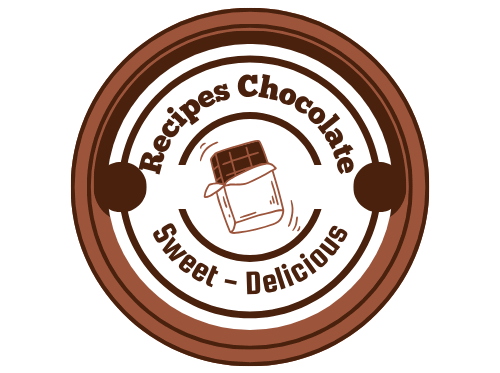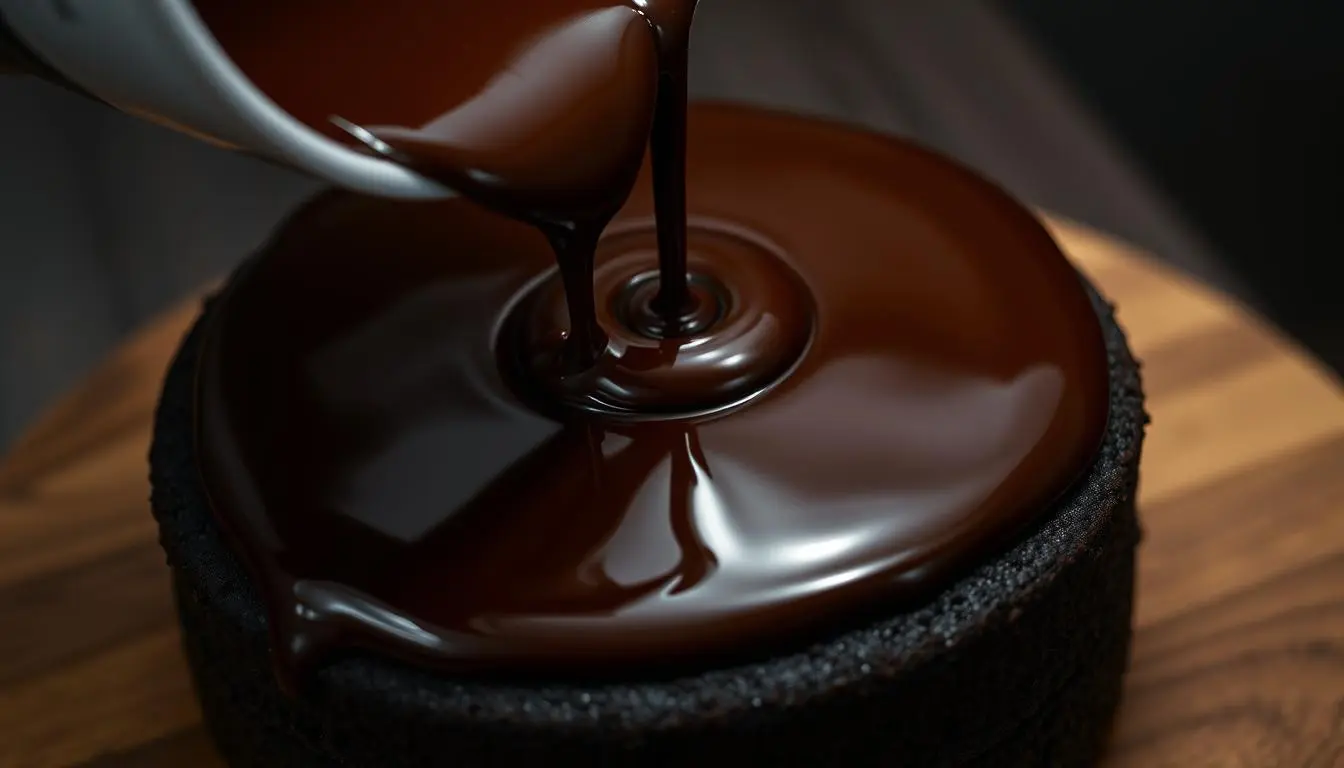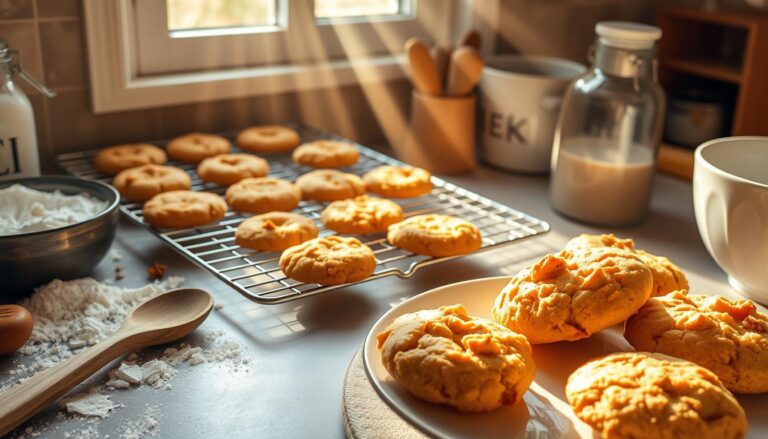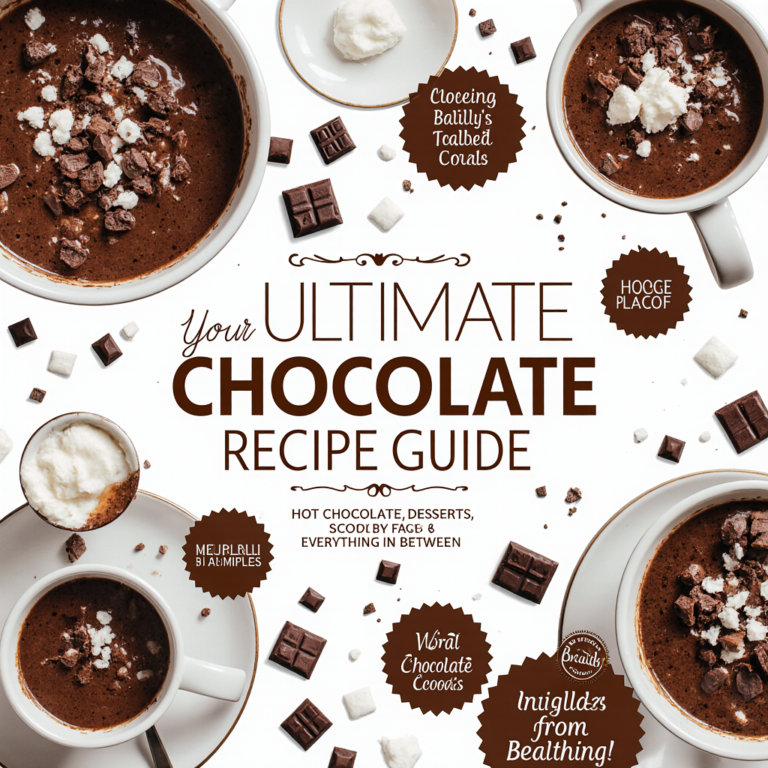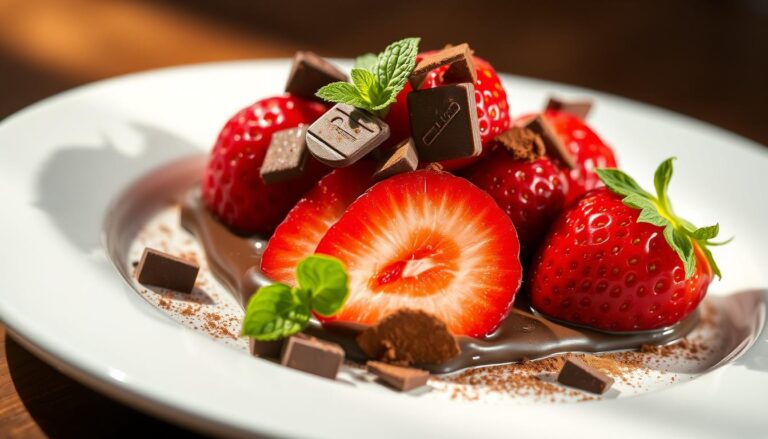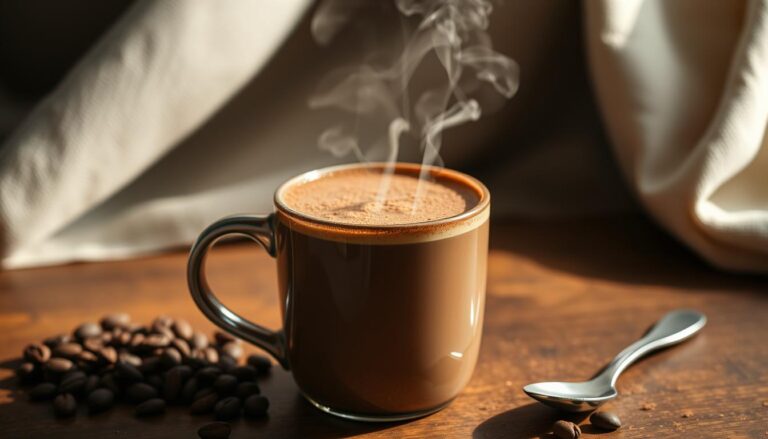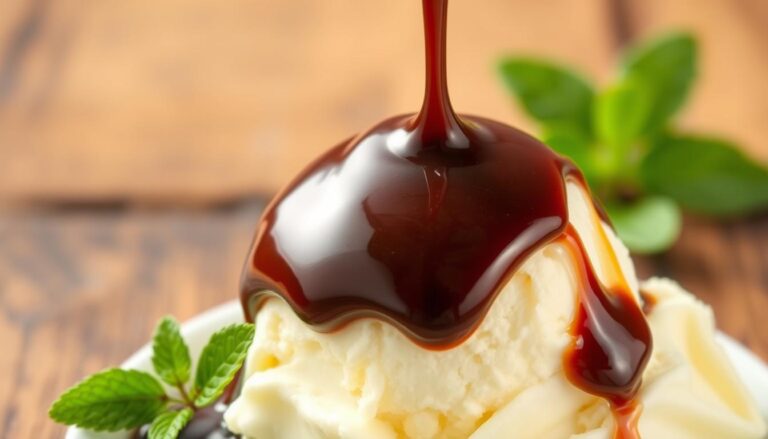How to Make Chocolate Ganache Like a Pro
The first time I saw a pastry chef make chocolate ganache, I was amazed. It was like magic. They mixed heavy cream and chocolate and turned it into a smooth sauce.
Chocolate ganache is more than a sauce. It’s a skill that both pros and home cooks can learn. It’s great for cake fillings, glazes, or truffle centers. Knowing how to make ganache is key to making desserts perfect.
In this guide, you’ll learn the basics and advanced techniques for ganache. You’ll become a better baker and impress everyone with your chocolate skills.
Key Takeaways
- Chocolate ganache is a versatile dessert technique
- Requires only two primary ingredients: chocolate and cream
- Can be used for multiple dessert applications
- Temperature and ingredient quality are crucial
- Mastering ganache elevates home baking skills
Understanding What Makes Perfect Chocolate Ganache
To make the perfect chocolate ganache, you need to know its science and how it’s made. Start by learning the basics that turn simple ingredients into a smooth chocolate frosting.
Chocolate ganache is more than melted chocolate and cream. It’s a complex mix that needs precision and skill.
The Science of Emulsification
Ganache is all about the science of mixing fats. It involves:
- Careful temperature management
- Balanced ingredient ratios
- Gentle mixing techniques
Critical Components of Ganache
The magic of chocolate ganache comes from two main ingredients:
| Ingredient | Role in Ganache |
| Chocolate | Provides rich flavor and structure |
| Heavy Cream | Creates smooth, luxurious texture |
Temperature Control Fundamentals
Mastering chocolate ganache means knowing how temperature changes its texture. Precise heating and cooling make it go from liquid to spreadable to firm. This is key for your needs.
By balancing ingredients and temperature, you’ll make a chocolate frosting that’s both professional and delicious.
Essential Ingredients for Classic Chocolate Ganache
Making the perfect chocolate ganache begins with picking top-notch ingredients. The success of your chocolate spread depends on the right mix. This mix turns simple items into a rich treat.
To make chocolate ganache, you need a few important ingredients. These ingredients greatly affect the taste and texture:
- High-quality dark or semi-sweet chocolate
- Heavy cream with at least 36% fat content
- Optional butter for extra richness
- Vanilla extract for enhanced flavor
The chocolate you choose is key to your chocolate topping. Pastry experts say use chocolate with 60% cocoa solids for the best taste.
| Ingredient | Quality Recommendation | Impact on Ganache |
| Chocolate | 60-70% cocoa solids | Deeper flavor, smoother texture |
| Heavy Cream | 36-40% fat content | Richer, more stable emulsion |
| Butter | European-style, unsalted | Added shine and smoothness |
Your choice of ingredients affects the ganache’s quality. Fresh, premium ingredients are essential for a top-notch chocolate spread. It will surely impress anyone who tries it.
Tools and Equipment You’ll Need
Making great chocolate ganache is more than just using top-notch ingredients. The right tools can make your ganache go from good to amazing. They help you get smooth chocolate drizzle and perfect icing every time.
Before you start making ganache, make sure your kitchen is ready. You’ll need the right tools for precision and quality.
Must-Have Kitchen Tools
- Heavy-bottomed saucepan for even heat distribution
- Silicone spatula for smooth mixing
- Stainless steel mixing bowls
- Whisk for creating smooth emulsions
- Sharp serrated knife for chopping chocolate
Optional Professional Equipment
If you want to take your ganache to the next level, consider these tools:
- Digital kitchen scale for precise measurements
- Immersion blender for ultra-smooth texture
- Pastry bags and tips for decorative chocolate icing
- Infrared thermometer for precise temperature control
Temperature Measuring Devices
Getting the temperature right is key in making ganache. Digital instant-read thermometers give you the most accurate readings. They help you get the perfect consistency for your chocolate drizzle or icing.
Getting quality tools might seem like a lot, but they really help improve your ganache-making skills and results.
Choosing the Right Chocolate for Your Ganache
Choosing the right chocolate is key to making great chocolate ganache. The chocolate you pick affects the taste, texture, and quality of your chocolate coating or syrup.
When picking chocolate for ganache, consider these key factors:
- Chocolate percentage
- Type of chocolate
- Quality of ingredients
- Intended use of ganache
Dark chocolate usually has 54% to 70% cocoa. Higher percentages mean deeper, more intense flavors. Milk chocolate is sweeter, with 35-45% cocoa. White chocolate is creamy and delicate.
Professional bakers say to use high-quality chocolate with little additives. Choose chocolate with cocoa butter, not vegetable oils. Single-origin chocolates can add special flavor notes to your ganache.
Your chocolate choice changes the whole feel of your syrup or coating. Try different percentages to find your favorite taste and texture.
“The quality of your chocolate determines the soul of your ganache.” – Pastry Chef Recommendation
Pro tip: Always taste your chocolate before making ganache. It should be rich, smooth, and not bitter or waxy.
The Perfect Chocolate-to-Cream Ratio Guide
Getting the chocolate ganache ratio right is crucial for a great dessert topping or filling. The mix of chocolate and cream affects the ganache’s texture and consistency. Knowing these ratios helps you make everything from smooth chocolate sauce to firm truffle centers.
To make the perfect chocolate ganache, start by picking the right ingredient mix. Recipes need different ratios to get the right texture and use.
Ratio Breakdown for Various Consistencies
- Pourable Chocolate Sauce: 1 part chocolate to 2 parts cream
- Medium Ganache: 1 part chocolate to 1 part cream
- Firm Truffle Filling: 2 parts chocolate to 1 part cream
Adjusting for Different Culinary Uses
Your chocolate ganache can change based on your cooking needs. A thinner sauce is great for drizzling over desserts. A firmer ganache is perfect for making delicate truffles or cake fillings.
Professional bakers suggest trying different chocolate types and cream ratios. Dark chocolate makes a richer ganache, while milk chocolate gives a softer, sweeter taste. The goal is to find the perfect mix for your recipe through practice.
Step-by-Step Guide to Basic Chocolate Ganache

A pristine kitchen counter, illuminated by soft natural light filtering through a nearby window. On the surface, a glass bowl filled with rich, velvety chocolate ganache. The mixture glistens as it’s gently stirred, revealing its smooth, glossy texture. Nearby, a saucepan of heavy cream simmers, its steam gently rising. Stainless steel tools, including a whisk and a spatula, are arranged neatly, ready to be used in the process of transforming the cream and chocolate into a decadent, silky-smooth ganache. The scene exudes a sense of calm and focus, inviting the viewer to imagine the delicious results of this simple yet precise culinary task.
Making perfect chocolate ganache needs precision and care. It’s great for a rich chocolate glaze on cakes or a smooth frosting for cupcakes. Learning the right technique is key for any home baker.
First, collect your ingredients with care. You’ll need top-notch chocolate and heavy cream. The quality of these affects the ganache’s texture and taste.
- Chop chocolate into small, uniform pieces to ensure even melting
- Heat cream until it reaches a gentle simmer
- Pour hot cream over chopped chocolate
- Let mixture sit for 2-3 minutes
- Stir until smooth and glossy
Temperature control is key when making chocolate ganache. Too hot, and the chocolate can separate; too cool, and it won’t blend properly. You want a gentle heat that mixes the ingredients well.
| Chocolate Type | Cream Ratio | Best Use |
| Dark Chocolate | 1:1 | Thick ganache, truffles |
| Milk Chocolate | 2:1 | Softer glaze, frosting |
| White Chocolate | 3:1 | Light drizzle, decoration |
After mixing, let your ganache cool at room temperature. For a firmer frosting, chill it briefly. Stir often to keep it smooth. With practice, you’ll make pro-quality ganache every time.
Troubleshooting Common Ganache Problems
Making the perfect chocolate spread or topping can be tricky. Even experienced bakers face challenges with ganache. But, most issues can be fixed with the right techniques.
Ganache making needs precision and understanding. Your chocolate creation might hit several common problems. These can ruin your dessert masterpiece.
Fixing Separated Ganache
Don’t panic if your ganache looks split or grainy. Separation often happens due to temperature changes or wrong mixing. Here are quick fixes:
- Warm the mixture gently using a double boiler
- Whisk vigorously to reincorporate ingredients
- Add a small amount of warm cream to stabilize
Dealing with Grainy Texture
A smooth chocolate spread needs proper chocolate melting. Graininess can come from:
- Overheated chocolate
- Low-quality chocolate
- Water contamination during preparation
“The key to silky ganache is patience and technique” – Professional Pastry Chef
Adjusting Thickness Issues
Your chocolate topping’s consistency is key. Too thick or thin ganache can mess up your dessert. Quick fixes include:
- Add warm cream to thin out ganache
- Cool mixture to thicken
- Incorporate additional chocolate for density
Pro tip: Always use high-quality chocolate and control temperatures precisely for perfect results.
Creative Ways to Use Chocolate Ganache
Chocolate ganache is more than just a tasty treat. It can turn simple desserts into amazing culinary experiences. You can use it for chocolate drizzle or icing, making your creations stand out.
Here are some fun ways to use chocolate ganache:
- Create smooth chocolate drizzle for cakes and pastries
- Use as a rich filling for truffles and bonbons
- Craft intricate chocolate icing decorations
- Develop glossy cake glazes
- Prepare silky chocolate mousses
Professional bakers love ganache for its amazing texture. You can whip it into a frosting, pour it as a glaze, or set it for decorations. The trick is knowing how to adjust its consistency.
| Ganache Application | Technique | Recommended Consistency |
| Cake Filling | Cooled to spreadable texture | Medium-thick |
| Chocolate Drizzle | Slightly warmed | Pourable |
| Truffle Centers | Fully cooled and firm | Solid |
Try different chocolates and cream ratios to find your own ganache recipe. Your imagination is the only limit with this versatile ingredient.
Storage Tips and Shelf Life
A neatly organized shelving unit filled with glass jars and containers of rich, glossy chocolate ganache. The jars are neatly labeled and arranged in rows, casting soft shadows on the wooden shelves. Warm, diffused lighting from above illuminates the scene, highlighting the smooth, velvety texture of the ganache. In the background, a clean, minimalist kitchen counter provides a clean, uncluttered backdrop. The overall atmosphere conveys a sense of order, quality, and attention to detail – reflecting the care and expertise required to properly store and preserve this versatile chocolate confection.
Keeping your chocolate ganache fresh is key. The right storage keeps it tasting great and feeling smooth. This way, you can enjoy it to the fullest.
Storing chocolate ganache right can make it last longer. The best method depends on the type of ganache and how you plan to use it.
Refrigeration Techniques
Here’s how to store chocolate ganache in the fridge:
- Use an airtight container to keep moisture out
- Keep it at 34-38°F consistently
- Put plastic wrap on top to stop skin from forming
- Use it within 7-10 days for the best taste
Freezing Your Ganache
Freezing is a great way to store your ganache for longer:
- Put ganache in a container safe for the freezer
- Get rid of air to avoid freezer burn
- Write the date you made it on the container
- Freeze for up to 3 months
Identifying Spoilage Signs
Look out for these signs that your ganache has spoiled:
- Unusual odor that’s not like fresh chocolate
- Mold growing on it
- It’s separated into different textures
- It’s changed color or has a gray/white film
Pro tip: Warm refrigerated or frozen ganache slowly to keep it smooth. A little reheating and stirring can make it perfect again for your desserts.
Advanced Ganache Techniques and Variations
Want to take your chocolate ganache to the next level? It’s all about creativity and trying new things. Professional pastry chefs show us how to turn chocolate ganache into amazing variations. These changes can make your desserts truly special.
- Flavored Ganache Innovations
- Infuse chocolate sauce with herbs like lavender or mint
- Add liqueurs for sophisticated adult desserts
- Incorporate spices like cinnamon or cardamom
- Alternative Ingredient Experiments
- Replace cream with nut milks for unique textures
- Use fruit purees to create fruity chocolate ganache
- Try coconut milk for dairy-free options
Making layered chocolate ganache is all about precision. Start by making different types of ganache. Then, layer them carefully to create a dessert that looks and tastes amazing.
| Ganache Variation | Key Ingredients | Unique Characteristic |
| Herbal Infusion | Dark chocolate, cream, fresh herbs | Aromatic and unexpected flavor profile |
| Liqueur Ganache | Milk chocolate, cream, Grand Marnier | Rich, complex adult dessert base |
| Fruit Puree Ganache | White chocolate, raspberry puree | Bright, tangy flavor transformation |
Professional bakers say to start slow with these advanced techniques. Each one needs careful attention to temperature and ingredient choice for the best results.
Pro tip: Always use high-quality chocolate and fresh ingredients when experimenting with ganache variations to ensure the best flavor and texture.
Professional Tips for Perfect Chocolate Coating
Mastering chocolate coating takes skill and precision. It’s about creating a luscious glaze for pastries or a smooth frosting. Professional techniques can make your desserts look amazing.
For a flawless coating, focus on detail and key techniques. Success hinges on controlling temperature and how you apply the chocolate.
Temperature Control Methods
Temperature is key for a top-notch chocolate coating. The right temperature range gives you a smooth texture and a shiny finish.
- Use a digital thermometer for precise measurements
- Keep chocolate between 88-90°F for optimal consistency
- Avoid overheating, which can cause chocolate to become grainy
Advanced Application Techniques
Professional bakers use various methods for stunning chocolate coatings:
- Dipping method: Submerge items completely for even coverage
- Pouring technique: Create smooth, cascading chocolate layers
- Spray coating: Achieve ultra-thin, uniform chocolate glaze
Learning these techniques can turn your chocolate frosting and glaze into works of art.
Conclusion
Making the perfect chocolate ganache is an art. It needs precision, quality ingredients, and skill. You’re on your way to becoming a chocolate ganache expert. This starts with knowing how to mix ingredients and control the temperature.
Whether you want a smooth chocolate spread or a fancy topping, you’re ready. The skills you’ve learned will make your desserts better.
Practice is essential to get better at making ganache. Every batch you make will teach you something new. You’ll learn how to pick the right chocolate and the perfect cream-to-chocolate ratio.
This will help you make a silky, luxurious chocolate spread. It can turn any dessert into something special.
Chocolate ganache is very versatile. You can use it on cakes, in pastries, or as a sauce for ice cream. The techniques you’ve learned will let you try new things and impress everyone.
So, enjoy the process and trust your skills. The delicious results of your chocolate-making journey will be worth it.
With patience and practice, you’ll soon make chocolate ganache as good as the pros. Your new skills invite you to explore the world of chocolate craftsmanship.
FAQ
What is chocolate ganache?
Chocolate ganache is a smooth, rich mix of heated cream and chocolate. It’s great for glazes, fillings, or frostings in desserts. Its consistency can vary from a thin sauce to a thick spread.
What type of chocolate works best for ganache?
For the best ganache, use high-quality couverture chocolate. You can choose from dark, milk, or white chocolate. Look for chocolate with lots of cocoa butter and few additives for the smoothest results.
How do I prevent my ganache from becoming grainy?
To avoid graininess, use top-notch chocolate and chop it finely. Pour hot cream over the chocolate and wait a bit before stirring. Stir gently and consistently to get a smooth mix.
Can I make ganache ahead of time?
Yes, you can make ganache ahead. Store it in an airtight container in the fridge for up to 7 days. When you’re ready, gently reheat and stir until it’s right.
What’s the difference between ganache ratios?
The ratio of chocolate to cream changes the ganache’s texture: – 1:1 (equal parts) makes a soft, spreadable ganache – 2:1 (more chocolate) gives a firmer ganache for truffles – 1:2 (more cream) creates a pourable glaze or sauce
How can I fix separated ganache?
If ganache separates, whisk in a bit of warm cream. Or use an immersion blender to mix it back together. Start with a tablespoon of warm cream at a time to smooth it out.
Can I use alternative milks in ganache?
Yes, you can try coconut milk or almond milk in ganache. But remember, they might change the texture and taste a bit. Full-fat versions work best for keeping a similar consistency.
How do I store leftover ganache?
Keep ganache in an airtight container in the fridge for up to a week. Cover the top with plastic wrap to prevent a skin. When you’re ready, gently reheat and stir until it’s smooth.
What are some creative ways to use ganache?
Ganache is super versatile! Use it as a cake filling, pour it over desserts as a glaze, or make truffles. You can also use it as frosting, dip fruits or cookies, or add it to no-bake desserts and mousses.
How can I flavour my ganache?
To add flavor to ganache, mix in extracts (vanilla, almond), liqueurs, spices (cinnamon, chili), or infuse the cream with herbs or tea before adding chocolate.
Did You Try Our Recipe ?
There are no reviews yet. Be the first one to write one.
